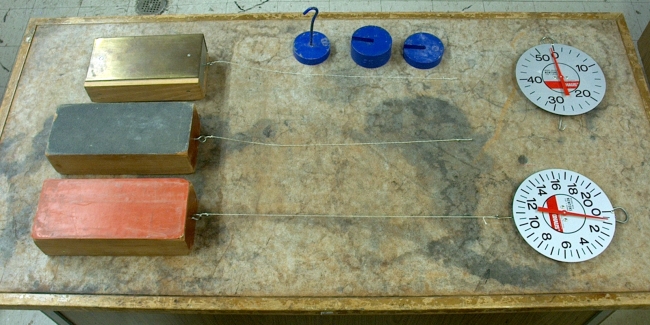
With this demonstration you can show static and kinetic friction.
Friction is the force generated between the surfaces of two objects in contact with each other, which opposes any applied force that would accelerate one object relative to the other. It acts opposite to the direction of this applied force, and depends linearly on the force that acts to keep the two surfaces together (which is perpendicular to the applied force). This is usually written as F = μN, where μ is the coefficient of friction (vide infra), and N is the normal force, that is, the force perpendicular to the contact surface.
If we attach a spring scale to one of the blocks shown above, and try to pull it across the table, we find that it takes a certain force to accelerate the block from rest. If we maintain that force, the block begins to accelerate, but for some smaller force, the block moves at constant speed. Hence, there are two manifestations of friction: static friction, which acts as long as the object is still at rest, and kinetic friction, which acts as long as the object is moving.
When our block is at rest, and we pull it with the spring scale, as we increase the tension the block stays at rest, until we reach a point where it begins to move. Up to that point, friction has been merely balancing the force we are applying with the spring scale. So we find that the static friction has a maximum value. We can express this as Fs ≤ μsN, where μs is the coefficient of static friction. N, as noted above, is the normal force, which for our block, is just mg, where m is the mass of the block, and g is the acceleration of gravity (9.8 m/s2). (For another demonstration that illustrates static friction, see demonstration 12.69 -- Slide blocks down incline.) Once the block is moving, the friction has a smaller, definite value, Fk = μkN, where μk is the coefficient of kinetic friction.
As we might guess from the above equations, friction is independent of the area or shape of the surfaces in contact (assuming that they are both flat or share the same curvature; that is, the shape itself does not keep the surfaces from sliding against each other). It does, however, depend on the nature of the surfaces that are in contact with each other – the materials they are made of and the surface finish. Thus, different pairs of materials have different coefficients of friction.
The various faces of the blocks shown in the photograph, either bare wood or covered with different materials, allow you to show how the friction changes as you choose different block faces to drag across the demonstration table, and the masses allow you to change the normal force by a known amount, to show how the friction depends on it.
The block in the foreground of the photograph above has one face covered with silicone rubber, one face bare, and bare edges. It has a mass of 1.97 kg, and so when lying on a level surface exerts a normal force of 19 N. The block in the middle has one face covered with mylar, one face covered with coarse sandpaper, and bare edges. Its mass is 1.88 kg, to give a normal force of 18 N. The block at the rear is made of aluminum, and its edges and faces are snap-in panels. One edge and one face are wood, and one edge and one face are brass. Its mass (with all faces) is 7.29 kg, for a normal force of 71 N.
References:
1) Resnick, Robert and Halliday, David. Physics, Part One, Third Edition (New York: John Wiley and Sons, 1977), p. 98, particularly figure 6-1 and accompanying text.